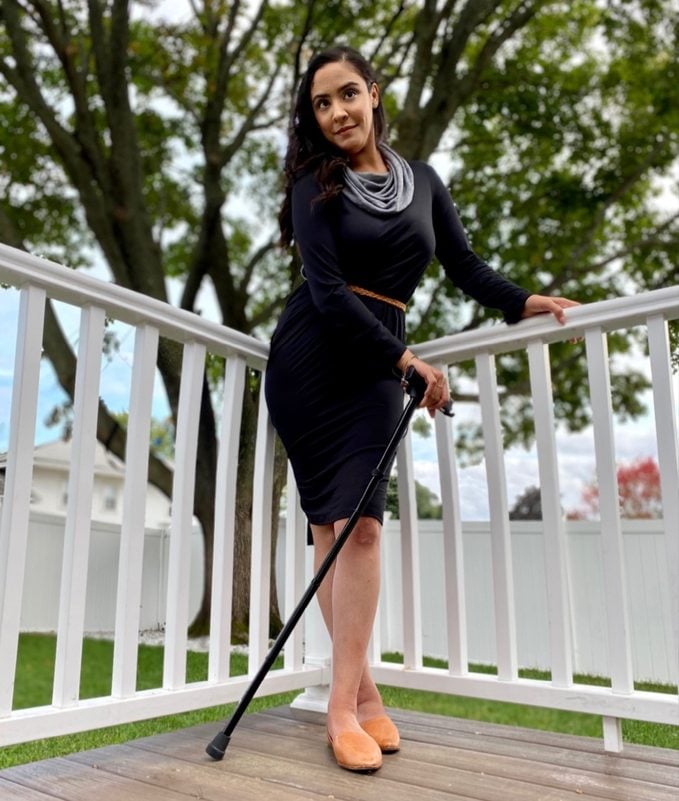“My foot just wasn’t working well.” She began to experience other symptoms, including pain in her body, fatigue, and trouble with her bladder. But when Aldelly saw her doctor, every symptom was explained away. He suggested that her foot problems might have been caused by a childhood of dancing, and the bladder issues and fatigue could be due to having recently given birth.

Aldelly knew something was wrong despite being told everything was okay. One day, at a work event, she broke down. She couldn’t walk, couldn’t control her bladder and she felt exhausted. She called her primary care physician from the event, who said she was going to send her to a neurologist. Aldelly wondered, “Did she think I was crazy?”
The neurologist did some tests, including an MRI, and later called Aldelly with a difficult diagnosis: she had neuromyelitis optica spectrum disorder, or NMOSD — a rare, lifelong and debilitating disease of the central nervous system.1 The disorder, which mainly causes inflammation and damage to the optic nerves and spinal cord, impacts up to 15,000 people in the United States.2 While it can affect anyone of any age, race, or gender, it is most commonly diagnosed in women in their 30s and 40s,1 and occurs at higher rates in people with African or Asian backgrounds.2
Like the condition itself, Aldelly’s quick diagnosis was, unfortunately, rare. Many people with NMOSD are misdiagnosed, especially since certain symptoms can seem similar to those of multiple sclerosis — but the two diseases are distinct.3,4
NMOSD causes relapses, or attacks, which can lead to loss of vision, fatigue, pain, muscle weakness, inability to walk and paralysis – the neurological damage can be permanent.1,3 These symptoms can have a serious impact on a person’s ability to do everyday things such as work, be active, socialize, or easily get around. Historically, prior to treatment advances made in the past few years, up to half of people with NMOSD required a wheelchair within five years of diagnosis, and more than 60 percent became functionally blind.2,3
The cumulative impact of NMOSD over time makes it critical that people with the condition are accurately diagnosed and treated.3 At the time Aldelly was diagnosed, there were no FDA-approved treatment options for people like her living with NMOSD. Fortunately, there has been progress over the past few years, and several treatments for NMOSD are now approved by the U.S. Food and Drug Administration.
At first, Aldelly didn’t want to believe the diagnosis. With a husband, two small children, a job, and a new house, she denied she had the disease. “I just didn’t have time for it.” The condition was making her life increasingly unpredictable–she often had spasticity in her limbs, incontinence, numbness, and tingling sensations — and even to this day, it prevents her from doing everyday activities, like taking her boys to football practice. “It’s a roller coaster,” she says. So for a long time, she pretended nothing was wrong. She would make excuses about a twisted ankle when she limped or explain away her cane by saying she’d been in a car accident.

Encouraged by her tight-knit family – her husband, sister and parents who live nearby – she decided to let her friends and her wider social media community know about her condition. “It allowed people to understand me, and for me to be myself,” she says. “People just started reaching out, which has helped a lot.” That support, both at home and in the wider world, have been crucial to her ability to cope with the condition.
With her support systems, Aldelly has learned to adjust to living with NMOSD and is “living fabulously,” as she puts it in her social media posts. She has made YouTube videos and written blogs about her diagnosis and journey with the condition. Bilingual in Spanish and English, Aldelly engages with people living with NMOSD all over the globe. “I feel as though my presence online has helped many people on their NMOSD journey,” she says.
The key to maintaining her positive attitude, Aldelly says, is being open-minded about having an adaptive lifestyle. “If you don’t adapt, you’re going to stay stuck in a dark place,” she says. After walking with a cane, and then using a wheelchair, she now zips around on an electric scooter. “I call it my fab mobile,” she says. She also credits her friends and family, especially her husband and children, with keeping her spirits up. “My mom still babies me, and my husband and children are so supportive, even though my kids are young,” she says.
As Aldelly made changes in her life, she even playfully held a funeral for her high heels. “My heels are gone,” she says. “But I’m staying positive.”

March is NMO Awareness Month. Learn more about the condition and how Aldelly and others like her with NMOSD are living their lives to the fullest.
1 Wingerchuk DM, Lennon VA, Lucchinetti CF, et al. Lancet Neurol 2007;6:805-815.
2 Guthy-Jackson Charitable Foundation. NMO FAQs. https://guthyjacksonfoundation.org/nmo-faqs.
3 Kessler RA, et al. Neurol Neuroimmunol Neuroinflamm 2016;3:e269.
4 Williamson_Poster_2018_ ICPE_Epidemiologic Temporal Trends of NMOSD
